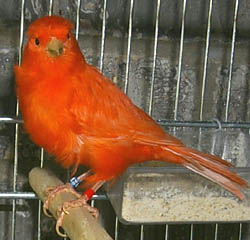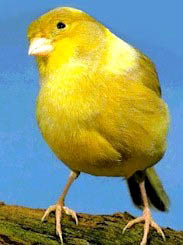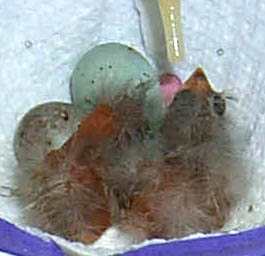Breeding Canaries
Canaries are more demanding than budgies in their feeding and husbandry requirements during the breeding season. With a bit of time and care, breeding this species can be very rewarding. The whole process, from egg laying to the time chicks become fully independent, takes around two months.

It is usually recommended to breed canaries in cages rather than in an aviary. In order to minimize disturbance to the breeding pair, the cage should not be positioned facing any other birds. Ideally, breeding cages should have a removable mesh partition down the middle. This partition allows the male to feed the female during courtship and keeps the couples separate until they are ready to mate.

Sexing
Male canaries are distinguished from females by the intensity and volume of their singing. Both the volume and intensity increase as they reach peak breeding condition. Females do not produce the same melodious song as males.
Timing
In the northern hemisphere, canaries reach their breeding condition in mid-March. It is good to introduce nesting boxes and other materials at this particular time.
Nesting
Canaries nest in open topped pans which can be made of metal, plastic or earthenware. The nesting pans should be lined with a soft material such as felt. In order for the female to weave the nest, additional nesting materials must also be provided. Suitable materials are shredded tissue paper, cat hair, hay, moss, cotton wool or rags. The strands of the nesting material must be short so that the bird's feet do not become entangled.
Egg Laying
On the average, canaries lay four or five eggs, although numbers can range from 2 to 6. The eggs are laid one a day, or every other day, and always early in the morning. Canary eggs are pale blue with tiny brown specks. If canary eggs were allowed to hatch out in the order they were laid, the chicks within the nest would be at different stages of Development. In order to avoid this situation, the eggs are generally removed from the nest during the laying period and only replaced when the clutch is complete. Each egg is removed from the nest at around noon on the day that it is laid and replaced with a dummy egg that can be purchased in pet shops. Once the eggs are removed, they can be kept on cotton wool at room temperature for up to two weeks.
Once the hen has stopped laying, the eggs can be replaced in the nest and the dummy eggs removed. At this point, incubation begins and lasts 13 to 14 days.
Diet
Females can be fed soft food for a few weeks prior to breeding and throughout the breeding season. A number of commercial rearing or conditioning soft foods are available, although many breeders prefer to make up their own mixtures from a variety of ingredients.
Cuttlefish bone and grit are important calcium sources and should be freely available during the breeding period.
Care of the young

Canaries are born naked and blind. In the nest, they are totally dependent upon their parents for food. They leave the nest around 16 days of age and begin to feed themselves.Soft rearing food can be introduced to the young on the second day after hatching.Occasionally, the male canary will attack the young; therefore, the parents should be watched during the rearing period.
Chicks can be removed from the parents when they are fully able to feed themselves. This occurs when chicks are approximately 25-30 days old.
[ Search Articles ] [ Article Index ]
